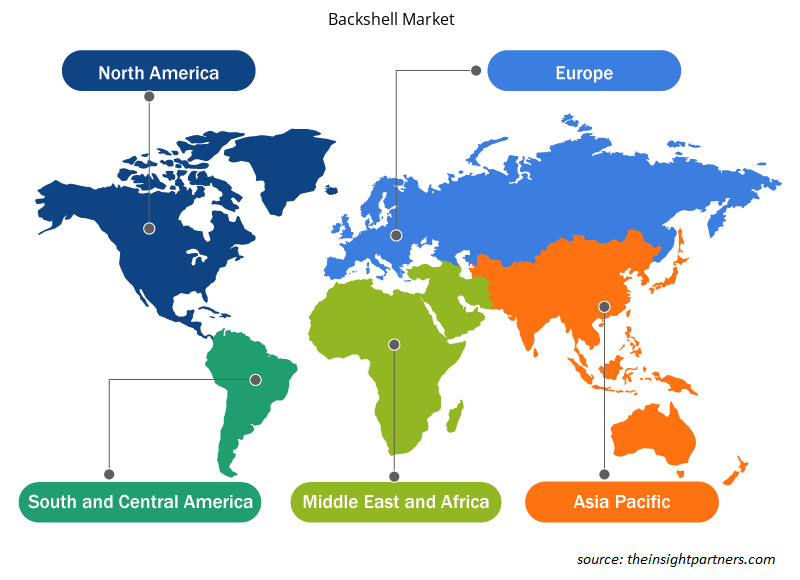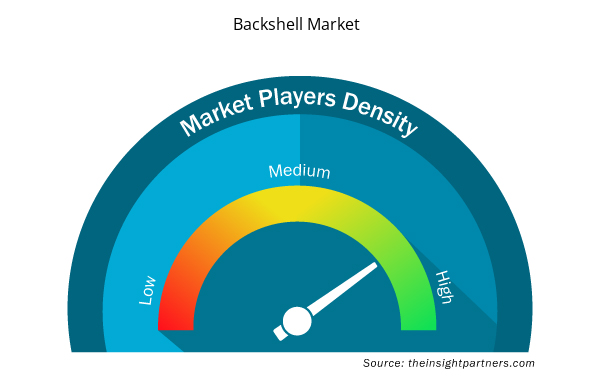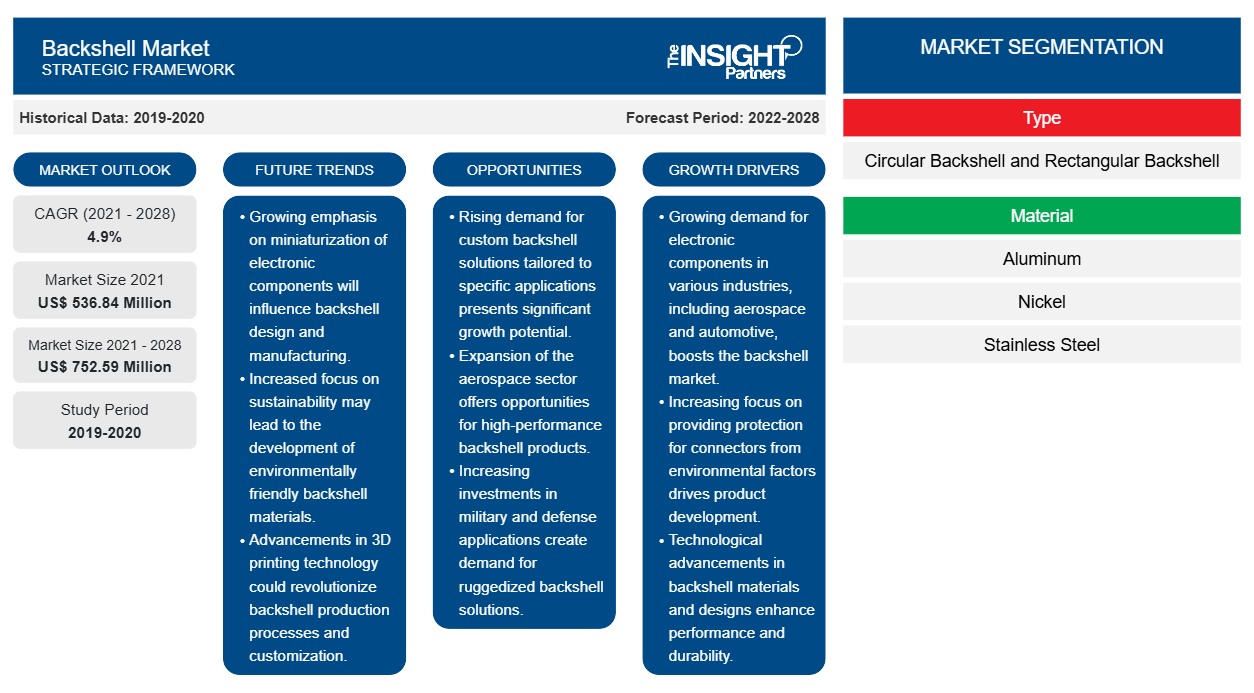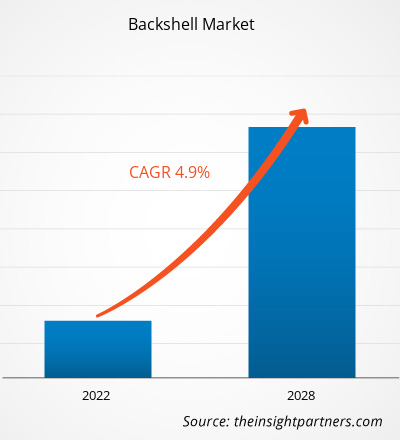Nel 2021 il mercato dei backshell era valutato 536,84 milioni di dollari USA e si prevede che raggiungerà i 752,59 milioni di dollari USA entro il 2028; si prevede una crescita a un CAGR del 4,9% dal 2021 al 2028.
L'industria automobilistica sta passando dai motori a combustione interna all'elettrificazione a causa delle crescenti preoccupazioni relative alle emissioni di carbonio. I veicoli utilizzati dalle forze armate sono principalmente alimentati a diesel e non hanno le capacità di manovrabilità rapida di un veicolo elettrico, come coppia aumentata, capacità di traino e capacità di arrampicata. Inoltre, la firma termica di un veicolo elettrico (EV) non può essere rilevata da una lunga distanza rispetto a un motore a combustione interna, il che rappresenta un vantaggio importante sul campo di battaglia. Attualmente, l'esercito americano sta valutando attivamente varie opzioni con i produttori di automobili per sviluppare veicoli elettrici per applicazioni militari. Ad esempio, nel 2020, la Maneuver Capabilities Development and Integration Directorate (MCDID) ha approvato lo studio di veicoli tattici e da combattimento con motori elettrici. Inoltre, a maggio 2021, la General Motors ha dimostrato un prototipo EV del suo Infantry Squad Vehicle (ISV) per applicazioni militari. Inoltre, il governo degli Stati Uniti ha assegnato contratti ad aziende per studiare varie tecniche per alimentare una futura flotta di 225.000 veicoli militari elettrici. Pertanto, lo sviluppo di veicoli elettrici per applicazioni militari stimolerebbe l'adozione di connettori di livello militare, che a loro volta stimolerebbero la crescita futura del mercato dei backshell .
Impatto della pandemia di COVID-19 sul mercato dei Backshell
Lo scoppio del COVID-19 ha avuto un impatto significativo sul mondo e continua a sconvolgere diversi paesi. Fino allo scoppio, l'industria aerospaziale e della difesa stava sperimentando una crescita sostanziale in termini di produzione, nonostante gli enormi arretrati dei produttori di aeromobili. L'industria aeronautica globale ha assistito a un aumento significativo del numero di passeggeri e all'aumento degli acquisti di aeromobili.
Sfortunatamente, lo scoppio del COVID-19 ha decimato la domanda di aeromobili in tutto il mondo. A causa della crisi, i produttori di aeromobili hanno assistito alla riduzione dei volumi di ordini, che ha portato a un numero inferiore di produzioni. Il calo dei volumi di produzione ha influenzato negativamente le attività di vari produttori di componenti e le tecnologie associate. Pertanto, le attività degli operatori del mercato dei backshell sono state gravemente colpite dalla destabilizzazione nella produzione di aeromobili. Durante lo scoppio del COVID-19, l'industria aerospaziale e della difesa ha assistito a un terremoto con risorse minime per prevedere il futuro. Diverse unità di produzione negli Stati Uniti, in Francia, in Russia e in Cina sono state temporaneamente chiuse per rispettare le regole governative in materia di blocco e distanziamento fisico. I produttori di aeromobili hanno assistito a una riduzione del 30-50% della domanda per la maggior parte dei modelli di aeromobili, in particolare modelli di aeromobili commerciali. Le restrizioni sulla produzione e l'assemblaggio di aeromobili e veicoli militari terrestri hanno ostacolato la domanda di backshell, con conseguente minore generazione di entrate. Questo fattore ha avuto un impatto negativo sul mercato dei backshell.
Personalizza questo report in base alle tue esigenze
Riceverai la personalizzazione gratuita di qualsiasi report, comprese parti di questo report, o analisi a livello nazionale, pacchetto dati Excel, oltre a usufruire di grandi offerte e sconti per start-up e università
- Scopri le principali tendenze di mercato in questo rapporto.Questo campione GRATUITO includerà analisi di dati che spaziano dalle tendenze di mercato alle stime e alle previsioni.
Approfondimenti sul mercato Backshell
Crescente utilizzo del guscio posteriore in alluminio
I gusci posteriori in alluminio stanno acquisendo importanza nel settore dell'aviazione commerciale, poiché i produttori di aeromobili commerciali (civili e di aviazione generale) si impegnano costantemente per ridurre il consumo di carburante e le emissioni di CO2 e aumentare la resistenza. L'uso di componenti metallici più pesanti limita gli OEM di aeromobili nel raggiungere i parametri sopra menzionati. Per questo motivo, l'uso di componenti o parti leggere sta aumentando tra questi produttori. Poiché gli OEM di aeromobili commerciali stanno enfatizzando i gusci posteriori in alluminio per vari connettori, la domanda di gusci posteriori in alluminio sta crescendo tra i fornitori di servizi MRO. Oltre ai proprietari della flotta di aeromobili di nuova fabbricazione, anche i proprietari della flotta di aeromobili esistente si stanno concentrando sul retrofit dei loro modelli di aeromobili con gusci posteriori in alluminio leggeri e avanzati poiché questi prodotti aumentano la durata dei connettori dal 4% all'8%. Inoltre, il retrofit dei gusci posteriori in alluminio aiuta a ridurre il peso degli aeromobili, facilitando così i proprietari della flotta di aeromobili nel realizzare le loro strategie di riduzione del peso e delle emissioni di CO2 e di maggiore resistenza. Per questo motivo, i fornitori di servizi MRO stanno acquistando sempre più gusci posteriori in alluminio, il che sta alimentando la crescita del mercato dei gusci posteriori.
Approfondimenti di mercato basati sul tipo
In base al tipo, il mercato dei backshell è diviso in circolare e rettangolare. Nel 2020, il segmento circolare ha guidato il mercato e ha rappresentato una quota maggiore.
Approfondimenti di mercato basati sui materiali
In base al materiale, il mercato del backshell è segmentato in alluminio, nichel, acciaio inossidabile e altri. Nel 2020, il segmento dell'acciaio inossidabile ha guidato il mercato e ha rappresentato la quota di mercato maggiore.
Approfondimenti di mercato basati sugli standard militari
In base agli standard militari, il mercato dei backshell è segmentato in AS85049 Series, MIL-DTL-38999, MIL-DTL-83723, MIL-DTL-5015, MIL-DTL-26482 e altri. Nel 2020, il segmento AS85049 Series ha guidato il mercato e ha rappresentato la quota di mercato maggiore.
Approfondimenti di mercato basati sulle applicazioni
In base all'applicazione, il mercato dei backshell è segmentato in terrestre, navale e aereo. Nel 2020, il segmento terrestre ha guidato il mercato e ha rappresentato la quota di mercato maggiore.
Gli operatori che operano nel mercato backshell adottano strategie quali fusioni, acquisizioni e iniziative di mercato per mantenere le loro posizioni nel mercato. Di seguito sono elencati alcuni sviluppi da parte degli operatori chiave:
- A maggio 2021, la linea DuraMateTM AHDM di connettori circolari metallici multi-pin, resistenti all'acqua e sigillati ecologicamente offre un sistema di bloccaggio a baionetta a collegamento rapido ed economico, progettato per gestire i rigori e le complessità delle applicazioni fuoristrada più impegnative.
- A gennaio 2020, Glenair Swing-Arm Flex Composite 3-in-1 Backshells ha fornito la terminazione di schermatura dei cavi EMI/RFI nei cavi di interconnessione dei fili elettrici, leggeri e privi di corrosione. Il tipico dispositivo di terminazione della schermatura per la riduzione del peso nelle applicazioni aeronautiche militari e commerciali è Glenair Swing-Arm Flex Composite 3-in-1 Backshells.
Approfondimenti regionali sul mercato Backshell
Le tendenze regionali e i fattori che influenzano il mercato Backshell durante il periodo di previsione sono stati ampiamente spiegati dagli analisti di Insight Partners. Questa sezione discute anche i segmenti e la geografia del mercato Backshell in Nord America, Europa, Asia Pacifico, Medio Oriente e Africa, e Sud e Centro America.

- Ottieni i dati specifici regionali per il mercato Backshell
Ambito del rapporto di mercato Backshell
| Attributo del report | Dettagli |
|---|---|
| Dimensioni del mercato nel 2021 | 536,84 milioni di dollari USA |
| Dimensioni del mercato entro il 2028 | 752,59 milioni di dollari USA |
| CAGR globale (2021 - 2028) | 4,9% |
| Dati storici | 2019-2020 |
| Periodo di previsione | 2022-2028 |
| Segmenti coperti | Per tipo
|
| Regioni e Paesi coperti | America del Nord
|
| Leader di mercato e profili aziendali chiave |
|
Densità dei player del mercato Backshell: comprendere il suo impatto sulle dinamiche aziendali
Il mercato Backshell Market sta crescendo rapidamente, spinto dalla crescente domanda degli utenti finali dovuta a fattori quali l'evoluzione delle preferenze dei consumatori, i progressi tecnologici e una maggiore consapevolezza dei vantaggi del prodotto. Con l'aumento della domanda, le aziende stanno ampliando le loro offerte, innovando per soddisfare le esigenze dei consumatori e capitalizzando sulle tendenze emergenti, il che alimenta ulteriormente la crescita del mercato.
La densità degli operatori di mercato si riferisce alla distribuzione di aziende o società che operano in un particolare mercato o settore. Indica quanti concorrenti (operatori di mercato) sono presenti in un dato spazio di mercato in relazione alle sue dimensioni o al valore di mercato totale.
Le principali aziende che operano nel mercato Backshell sono:
- Società per azioni Amphenol
- Arrow Electronics, Inc.
- Azienda aerospaziale Collins.
- Società per azioni Curtiss Wright
- Glenair, Inc.
Disclaimer : le aziende elencate sopra non sono classificate secondo un ordine particolare.

- Ottieni la panoramica dei principali attori chiave del mercato Backshell
Il mercato globale dei gusci posteriori è stato segmentato come indicato di seguito:
Per tipo
- Guscio posteriore circolare
- Guscio posteriore rettangolare
Per materiale
- Alluminio
- Nichel
- Acciaio inossidabile
- Altri
Secondo gli standard militari
- AS85049,
- MIL-DTL-38999,
- MIL-DTL-83723,
- MIL-DTL-5015,
- MIL-DTL-26482 e altri
- Altri
Per applicazione
- Terra
- Aria
- Navale
Per Geografia
America del Nord
- NOI
- Canada
- Messico
Europa
- Francia
- Germania
- Italia
- Regno Unito
- Russia
- Resto d'Europa
Asia Pacifico (APAC)
- Cina
- India
- Corea del Sud
- Giappone
- Australia
- Resto dell'APAC
Medio Oriente e Africa (MEA)
- Sudafrica
- Arabia Saudita
- Emirati Arabi Uniti
- Resto del MEA
America del Sud (SAM)
- Brasile
- Resto del SAM
Profili aziendali
- Società per azioni Amphenol
- Elettronica Arrow, Inc.
- Azienda aerospaziale Collins
- Società per azioni Curtiss Wright
- Glenair, Inc
- Isodina Inc.
- Pei-Genesi
- Spiaggia di Souriau (Eaton)
- Connettività TE
- Azienda Techniran Ltd.
- Analisi storica (2 anni), anno base, previsione (7 anni) con CAGR
- Analisi PEST e SWOT
- Valore/volume delle dimensioni del mercato - Globale, regionale, nazionale
- Industria e panorama competitivo
- Set di dati Excel


- Industrial Inkjet Printers Market
- Rare Neurological Disease Treatment Market
- Artificial Turf Market
- Online Recruitment Market
- Architecture Software Market
- Tortilla Market
- Hair Extensions Market
- Truck Refrigeration Market
- Quantitative Structure-Activity Relationship (QSAR) Market
- Queue Management System Market

Report Coverage
Revenue forecast, Company Analysis, Industry landscape, Growth factors, and Trends

Segment Covered
This text is related
to segments covered.

Regional Scope
North America, Europe, Asia Pacific, Middle East & Africa, South & Central America

Country Scope
This text is related
to country scope.
Domande frequenti
North America held the significant market share in year 2020, along with the notable revenue generation opportunities in Europe and APAC.
A few key players operating in the backshell market are Amphenol Corporation; Arrow Electronics, Inc.; Collins Aerospace.; Curtiss Wright Corporation; Glenair, Inc.; Isodyne Inc.; Pei-Genesis; Souriau Sunbank (Eaton); TE Connectivity; and Techniran Ltd.
The automotive industry is undergoing a shift from internal combustion engines to electrification owing to the increasing concerns regarding carbon emission. The vehicles used armed forces are major diesel-powered and it lacks the quick maneuverability capabilities of an electric-powered vehicle, such as increased torque, towing capability, and climbing ability. Moreover, the thermal signature of an Electric Vehicle (EV) cannot be detected from a long distance that of an internal combustion engine, which acts as a major benefit on the battlefield. Currently, the US Army is actively evaluating various options with automotive manufacturers to develop electric vehicles for military applications. For instance, in 2020, the Maneuver Capabilities Development and Integration Directorate (MCDID) approved the study of tactical and combat vehicles with electric engines.
Based on type, the market is bifurcated into rectangular, and circular. In 2020, the circular segment led the type segment and accounted for a larger market share.
Growing Use of Aluminum Backshell
Increasing Military Expenditures
With the growing concern over carbon emissions, various industries are getting inclined toward the adoption of clean technology to reduce their respective carbon footprints. In terms of transportation, the automotive industry is currently experiencing a significant shift toward electrification. However, the aerospace industry is investing notably in developing electric aircraft. The rising price of fuels is one of the major factors that are driving the aerospace industry to develop electric solutions. Moreover, half of all global flights are shorter than 500 miles. The military-grade connectors along with respective backshells have their applications in commercial electric aircraft. Thus, the emergence of electric aircraft is expected to create lucrative growth opportunities for the backshell market in the coming years, as the electric aircraft models would require significantly higher volumes of connectors.
Trends and growth analysis reports related to Aerospace and Defense : READ MORE..
The List of Companies - Backshell Market
- Amphenol Corporation
- Arrow Electronics, Inc.
- Collins Aerospace.
- Curtiss Wright Corporation
- Glenair, Inc.
- Isodyne Inc.
- Pei-Genesis
- Souriau Sunbank (Eaton)
- TE Connectivity
- Techniran Ltd
The Insight Partners performs research in 4 major stages: Data Collection & Secondary Research, Primary Research, Data Analysis and Data Triangulation & Final Review.
- Data Collection and Secondary Research:
As a market research and consulting firm operating from a decade, we have published and advised several client across the globe. First step for any study will start with an assessment of currently available data and insights from existing reports. Further, historical and current market information is collected from Investor Presentations, Annual Reports, SEC Filings, etc., and other information related to company’s performance and market positioning are gathered from Paid Databases (Factiva, Hoovers, and Reuters) and various other publications available in public domain.
Several associations trade associates, technical forums, institutes, societies and organization are accessed to gain technical as well as market related insights through their publications such as research papers, blogs and press releases related to the studies are referred to get cues about the market. Further, white papers, journals, magazines, and other news articles published in last 3 years are scrutinized and analyzed to understand the current market trends.
- Primary Research:
The primarily interview analysis comprise of data obtained from industry participants interview and answers to survey questions gathered by in-house primary team.
For primary research, interviews are conducted with industry experts/CEOs/Marketing Managers/VPs/Subject Matter Experts from both demand and supply side to get a 360-degree view of the market. The primary team conducts several interviews based on the complexity of the markets to understand the various market trends and dynamics which makes research more credible and precise.
A typical research interview fulfils the following functions:
- Provides first-hand information on the market size, market trends, growth trends, competitive landscape, and outlook
- Validates and strengthens in-house secondary research findings
- Develops the analysis team’s expertise and market understanding
Primary research involves email interactions and telephone interviews for each market, category, segment, and sub-segment across geographies. The participants who typically take part in such a process include, but are not limited to:
- Industry participants: VPs, business development managers, market intelligence managers and national sales managers
- Outside experts: Valuation experts, research analysts and key opinion leaders specializing in the electronics and semiconductor industry.
Below is the breakup of our primary respondents by company, designation, and region:

Once we receive the confirmation from primary research sources or primary respondents, we finalize the base year market estimation and forecast the data as per the macroeconomic and microeconomic factors assessed during data collection.
- Data Analysis:
Once data is validated through both secondary as well as primary respondents, we finalize the market estimations by hypothesis formulation and factor analysis at regional and country level.
- Macro-Economic Factor Analysis:
We analyse macroeconomic indicators such the gross domestic product (GDP), increase in the demand for goods and services across industries, technological advancement, regional economic growth, governmental policies, the influence of COVID-19, PEST analysis, and other aspects. This analysis aids in setting benchmarks for various nations/regions and approximating market splits. Additionally, the general trend of the aforementioned components aid in determining the market's development possibilities.
- Country Level Data:
Various factors that are especially aligned to the country are taken into account to determine the market size for a certain area and country, including the presence of vendors, such as headquarters and offices, the country's GDP, demand patterns, and industry growth. To comprehend the market dynamics for the nation, a number of growth variables, inhibitors, application areas, and current market trends are researched. The aforementioned elements aid in determining the country's overall market's growth potential.
- Company Profile:
The “Table of Contents” is formulated by listing and analyzing more than 25 - 30 companies operating in the market ecosystem across geographies. However, we profile only 10 companies as a standard practice in our syndicate reports. These 10 companies comprise leading, emerging, and regional players. Nonetheless, our analysis is not restricted to the 10 listed companies, we also analyze other companies present in the market to develop a holistic view and understand the prevailing trends. The “Company Profiles” section in the report covers key facts, business description, products & services, financial information, SWOT analysis, and key developments. The financial information presented is extracted from the annual reports and official documents of the publicly listed companies. Upon collecting the information for the sections of respective companies, we verify them via various primary sources and then compile the data in respective company profiles. The company level information helps us in deriving the base number as well as in forecasting the market size.
- Developing Base Number:
Aggregation of sales statistics (2020-2022) and macro-economic factor, and other secondary and primary research insights are utilized to arrive at base number and related market shares for 2022. The data gaps are identified in this step and relevant market data is analyzed, collected from paid primary interviews or databases. On finalizing the base year market size, forecasts are developed on the basis of macro-economic, industry and market growth factors and company level analysis.
- Data Triangulation and Final Review:
The market findings and base year market size calculations are validated from supply as well as demand side. Demand side validations are based on macro-economic factor analysis and benchmarks for respective regions and countries. In case of supply side validations, revenues of major companies are estimated (in case not available) based on industry benchmark, approximate number of employees, product portfolio, and primary interviews revenues are gathered. Further revenue from target product/service segment is assessed to avoid overshooting of market statistics. In case of heavy deviations between supply and demand side values, all thes steps are repeated to achieve synchronization.
We follow an iterative model, wherein we share our research findings with Subject Matter Experts (SME’s) and Key Opinion Leaders (KOLs) until consensus view of the market is not formulated – this model negates any drastic deviation in the opinions of experts. Only validated and universally acceptable research findings are quoted in our reports.
We have important check points that we use to validate our research findings – which we call – data triangulation, where we validate the information, we generate from secondary sources with primary interviews and then we re-validate with our internal data bases and Subject matter experts. This comprehensive model enables us to deliver high quality, reliable data in shortest possible time.


 Ottieni un campione gratuito per questo repot
Ottieni un campione gratuito per questo repot